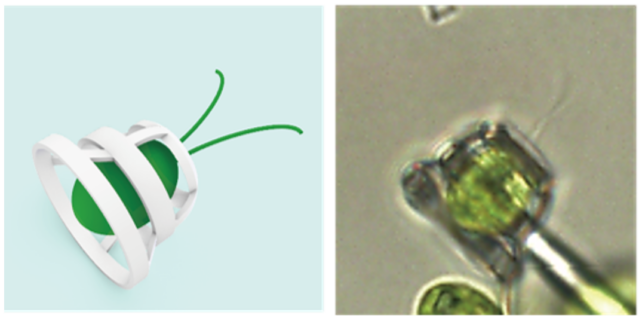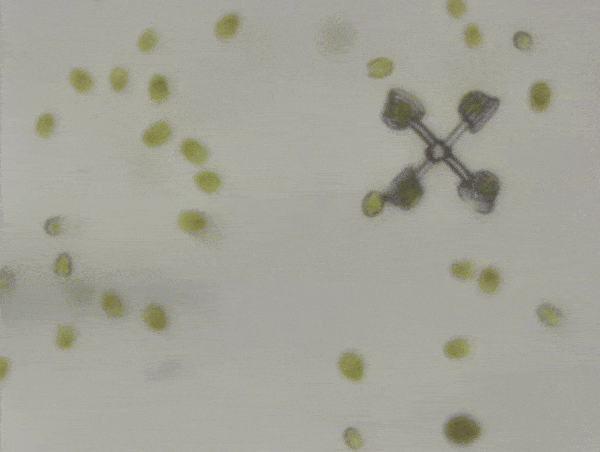Sixty-five years on, scientists are getting closer to that fact.
Engineers at the University of Tokyo have now discovered a strategy to motorize tiny micro-buildings without the need for an external energy source.
Answer? A team of freely moving, single-celled organisms resembled a ‘chariot’ of itty-bitty horses.
This analysis was not simply a pursuit of beauty, even if every part of it is as beautiful as it sounds. One of the biggest problems with ‘microbots’ designed to this point is that, being so microscopic, fluids like blood can quickly increase in viscosity to molasses.
This makes it difficult for the bot to move, which is why scientists have tried for years to create small motors strong enough to run such buildings with better entertainment.
Using the quick swimming skills of golf green algae chlamydomonas reinhardtiiEngineers in Japan have found a unique answer.
every mobile of C. reinhardtii It is a maximum of 10 micrometres in width, one-third the scale of the Benchie tugboat – the smallest ship on Earth, 3-D-printed in 2020.
On the other hand, in combination, they may be able to speed up machines up to 5 times their individual size – “opening up a new realm of possibilities for the development of complex micromachines”, say the system’s designers.
The algae, which can be considered shields for human consumption, are propelled by means of two flagella, which propel each unit forward in a breaststroke-related strategy.
Trapped in a specially designed bridle-like basket, the mobile’s flagella stick forward, allowing it to pull the vehicle’s excess rearward while paddling.

Unlike alternative micromotors designed by scientists – which rely on external energy resources such as constant magnetic or electrical currents – living motors such as C. reinhardtii Can move autonomously.
Managing producer Haruka Oda and her colleagues designed two other, 3-D-printed plastic cars, each between 50 and 60 microns wide, to impact the algae. The thickness of a typical human hair is determined to be 100 microns during viewpoint.
One of the most microscopic machines is known as a “scooter”. It has two baskets to trap two cells of algae, one of which faces the same path and is attached to a ‘chariot’ at the rear.
without any sign, C. reinhardtii Be sure of your position in each cockpit.
The researchers were surprised to find that the scooter did not move immediately, even though each basket was attached. In turn, it revolved and transformed into complex techniques. It even performed 15 back-flips and 10 rolling actions.

The alternative automobile situation, called a “rotator”, runs more smoothly. It was once designed with four baskets, all of which could be pointed in the same direction and connected using spokes in a wheel-like structure.
With each of the four baskets occupied by one algal cell, the structure ‘spins’ at an average speed of 20 to 40 micrometres per second, almost like a trip into a microscopic carnival.

C. reinhardt They can achieve speeds of 100 micrometers per second when unencumbered, so researchers are really looking to see if they can make those micromachines run faster and with extra precision.
The rotator, which was only 56 micrometres in size, 5 times better than any other previously designed microvehicle, was created in 2017 to be powered by self-propelled bacteria. On the other hand, unlike algae, the rate of these microorganisms needs to be controlled through a specific luminance modulator.
Shoji Takeuchi, who oversees the undertaking, says, “The methods developed here are useful not only for observing individual movements of algae, but also for developing a tool that can analyze their coordinated movements under restricted conditions. ”
“These methods have the potential to be developed in the future into a technique that can be used for environmental monitoring in aquatic environments and for using microorganisms to transport substances, such as pollutants or nutrients, in water. Carry.”
In one age, those traces of study might even result in Feynman’s dream of a microbot that hands out ‘mini shipments’ driven by age, like blood, in liquid order, like medicines.
news was published about it Small,
Discover more from news2source
Subscribe to get the latest posts sent to your email.




